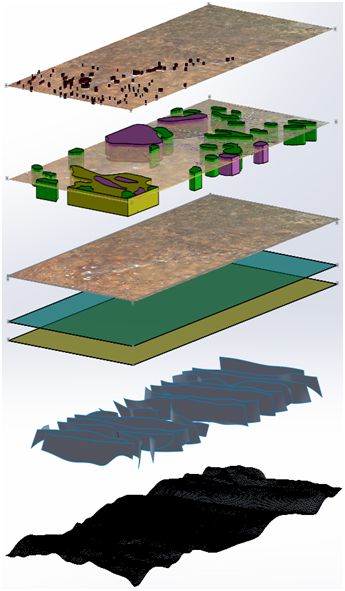Overview – Africa New Energies Technological Approach
Conventional onshore hydrocarbon exploration typically relies on surface formation surveys and active seismic geophysical surveys before drilling the first well. Surface formation surveys provide the location of faults or anticlines at the surface. Seismic surveys provide a picture of the subterranean rock formations, as well as information on what type of rock is present.
Both techniques are important because they indicate where potential structural traps may exist. With even the most sophisticated three-dimensional seismic surveys, the likelihood of drilling a dry well in a location where both conventional techniques indicate a hydrocarbon trap is no less than 60%.
ANE’s exploration strategy differs from conventional exploration programs in that it incorporates data from far more exploration techniques.

While ANE’s multilayer model, a visualisation of 7 of the 17 subsurface layers.
ANE’s exploration strategy still considers seismic surveys (passive seismic) and surface formation surveys, it also includes surveys from other less conventionally used exploration techniques before drilling the first exploratory well. These techniques include Remote Sensing, Airborne Surveying, and Geochemical Sampling.
Data recorded from each exploratory technique is processed by ANE’s technical team into 17 independent layers. Each layer independently provides information on the subterranean formation, and/or the likelihood and/or type of hydrocarbon at any particular location on the surveyed area.
These layers are then collated to create a multi-layer model, and a predetermined threshold interlayer agreement value is set. The model is then run through ANE’s algorithm, which processes it in terms of interlayer agreement. The algorithm calculates the likelihood of the existence of a range of hydrocarbons on the surveyed area. If any locations on the model present as having a higher level of interlayer agreement than the threshold value, the location is identified as a high probability well location.
ANE estimates that with its holistic multi-layer exploration technique, the likelihood of drilling a dry well in a high probability well location is approximately 20%, 40% better than that of conventional exploration programmes.
ANE’s exploration approach consists primarily of 5 handpicked conventional and non – conventional exploration techniques. These techniques are: Surface Formation surveying, Remote Sensing, Passive Seismic Tomography Surveying, Airborne Surveying, and Geochemical Sampling. The following subsections will now provide a high-level explanation of each of these exploration techniques.